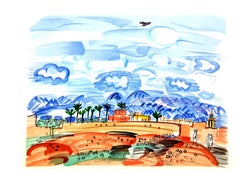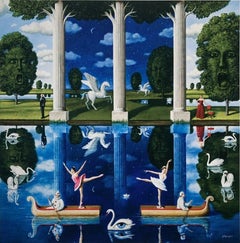Continental Europe - Portrait Prints
Mid-20th Century Cubist Continental Europe - Portrait Prints
Lithograph
1940s Fauvist Continental Europe - Portrait Prints
Lithograph
2010s Street Art Continental Europe - Portrait Prints
Mixed Media, Pigment, Archival Pigment
2010s Surrealist Continental Europe - Portrait Prints
Paper, Color
1990s Modern Continental Europe - Portrait Prints
Lithograph
Late 20th Century Expressionist Continental Europe - Portrait Prints
Lithograph
2010s Surrealist Continental Europe - Portrait Prints
Metal
2010s Contemporary Continental Europe - Portrait Prints
Metal
1950s Art Deco Continental Europe - Portrait Prints
Ceramic
1890s Modern Continental Europe - Portrait Prints
Woodcut
1950s Surrealist Continental Europe - Portrait Prints
Lithograph
Mid-20th Century Cubist Continental Europe - Portrait Prints
Lithograph
Mid-20th Century Italian School Continental Europe - Portrait Prints
Etching
Late 20th Century Modern Continental Europe - Portrait Prints
Lithograph
1980s Contemporary Continental Europe - Portrait Prints
Lithograph
20th Century Abstract Continental Europe - Portrait Prints
Drypoint, Etching
Late 20th Century Expressionist Continental Europe - Portrait Prints
Lithograph
Late 20th Century Modern Continental Europe - Portrait Prints
Lithograph
1920s Modern Continental Europe - Portrait Prints
Lithograph
1890s Modern Continental Europe - Portrait Prints
Woodcut
1950s Modern Continental Europe - Portrait Prints
Lithograph
Late 20th Century Cubist Continental Europe - Portrait Prints
Lithograph
1870s Impressionist Continental Europe - Portrait Prints
Etching
1970s American Modern Continental Europe - Portrait Prints
Offset
2010s Pop Art Continental Europe - Portrait Prints
Metal
Late 20th Century Modern Continental Europe - Portrait Prints
Lithograph
1960s Modern Continental Europe - Portrait Prints
Lithograph
1920s Modern Continental Europe - Portrait Prints
Lithograph
Late 20th Century Modern Continental Europe - Portrait Prints
Lithograph
2010s Pop Art Continental Europe - Portrait Prints
Mixed Media, Pigment, Archival Pigment
2010s Surrealist Continental Europe - Portrait Prints
Paper, Color
1960s Fauvist Continental Europe - Portrait Prints
Lithograph
2010s Street Art Continental Europe - Portrait Prints
Mixed Media, Pigment, Archival Pigment
1970s Abstract Continental Europe - Portrait Prints
Lithograph
1970s Surrealist Continental Europe - Portrait Prints
Etching
2010s Street Art Continental Europe - Portrait Prints
Mixed Media, Pigment, Archival Pigment
1940s Fauvist Continental Europe - Portrait Prints
Lithograph
2010s Surrealist Continental Europe - Portrait Prints
Paper, Color
Late 20th Century Expressionist Continental Europe - Portrait Prints
Lithograph
1910s Modern Continental Europe - Portrait Prints
Lithograph
21st Century and Contemporary Contemporary Continental Europe - Portrait Prints
Archival Pigment
Early 2000s Modern Continental Europe - Portrait Prints
Lithograph
1950s Surrealist Continental Europe - Portrait Prints
Lithograph
2010s Conceptual Continental Europe - Portrait Prints
Wood, Acrylic
1920s Modern Continental Europe - Portrait Prints
Lithograph
2010s Pop Art Continental Europe - Portrait Prints
Mixed Media, Pigment, Archival Pigment
1950s Contemporary Continental Europe - Portrait Prints
Lithograph
Late 20th Century Contemporary Continental Europe - Portrait Prints
Etching
1850s Contemporary Continental Europe - Portrait Prints
Etching
Late 20th Century Modern Continental Europe - Portrait Prints
Screen
1870s Impressionist Continental Europe - Portrait Prints
Etching
2010s Pop Art Continental Europe - Portrait Prints
Mixed Media, Pigment, Archival Pigment
2010s Pop Art Continental Europe - Portrait Prints
Mixed Media, Pigment, Archival Pigment
Mid-19th Century Realist Continental Europe - Portrait Prints
Etching
20th Century Pop Art Continental Europe - Portrait Prints
Offset
1970s Modern Continental Europe - Portrait Prints
Etching
1950s Cubist Continental Europe - Portrait Prints
Lithograph, Stencil
21st Century and Contemporary Pop Art Continental Europe - Portrait Prints
Plexiglass, Pigment
1970s Modern Continental Europe - Portrait Prints
Lithograph
1910s Modern Continental Europe - Portrait Prints
Woodcut



